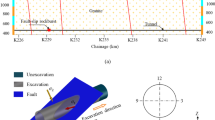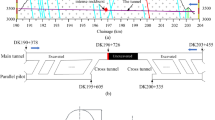Abstract
Delayed rockburst occurs after the stress adjustment of surrounding rocks with discontinuous microseismicity, which is difficult to predict accurately. To predict and prevent the occurrence of the delayed rockbursts, study on time behavior of the surrounding rock failure and the mechanism behind the delayed rockbursts is necessary. In this article, based on the rockburst data from Jinping II Hydropower Station headrace tunnels, China, the characteristics of the delayed rockbursts are summarized. Considering the microseismic monitoring results of two typical delayed rockbursts, the formation process of delayed rockbursts is analyzed. Subsequently, the time behavior of rock failure is revealed by a uniaxial constant loading test. The results from our study suggest the surrounding rocks are in a relatively stable state, where the delayed rockburst occurs. Geo-stress, geological conditions and excavation are the key factors affecting the delayed rockbursts. Within the rockburst-affected area, the microseismic activities were frequent during the early stage of excavation, then the stress adjustment of the surrounding rocks gradually stabilized. As a result, the surrounding rocks were in a dormant stage, under the long-term high stress. Supported by laboratory experiments, our results suggest an obvious time behavior in the rock failure which corresponds to the time behavior of the crack propagation, under the high stress. Under the condition of long-term high stress, when the damage is accumulated to a certain extent, the rock mass is destabilized and then the rockburst is triggered, accordingly. The results from this study can provide a reference for the prediction and prevention of the delayed rockbursts, in similar situations, e.g. deep-buried tunnels, around the world.













Similar content being viewed by others
Abbreviations
- r :
-
Radius of the rupture plane
- \(v_{\text{S}}\) :
-
S-wave velocity
- \(f_{\text{S}}\) :
-
Corner frequency of the S-wave
- \(M_{0}\) :
-
Seismic moment
- μ :
-
Shear modulus of the rock mass
- \(\bar{u}\) :
-
Average slip displacement
- \(E_{\text{d}}\) :
-
Energy density
- E :
-
Seismic energy
- \(V_{\text{A}}\) :
-
Apparent volume
- \(\sigma_{\text{A}}\) :
-
Apparent stress
- \(E_{\text{S}}\) :
-
S-wave energy
- \(E_{\text{P}}\) :
-
P-wave energy
References
Aki K (1968) Seismic displacements near a fault. J Geophys Res 73(16):5359–5376
Aydan Ö, Ito T, Özbay U, Kwasniewski M, Shariar K, Okuno T, Özgenoğlu A, Malan DF, Okada T (2013) ISRM suggested methods for determining the creep characteristics of rock. Rock Mech Rock Eng 47(1):275–290
Bieniawski ZT (1970) Time-dependent behaviour of fractured rock. Rock Mech 2:123–137
Brune JN (1970) Tectonic stress and the spectra of seismic shear waves from earthquakes. J Geophys Res 75(26):4997–5009
Duan K, Ji Y, Wu W, Kwok CY (2019) Unloading-induced failure of brittle rock and implications for excavation-induced strain burst. Tunn Undergr Space Technol 84:495–506
Duplancic P (2001) Characterisation of caving mechanisms through analysis of stress and seismicity, Doctoral dissertation. University of Western Australia
Feng XT, Chen BR, Li SJ, Zhang CQ, Xiao YX, Feng GL, Zhou H, Qiu SL, Zhao ZN, Yu Y, Chen DF, Ming HJ (2012) Studies on the evolution process of rockbursts in deep tunnels. J Rock Mech Geotech Eng 4(4):289–295
Gibowicz SJ, Young RP, Talebi S, Rawlence DJ (1991) Source parameters of seismic events at the Underground Research Laboratory in Manitoba, Canada: Scaling relations for events with moment magnitude smaller than − 2. Bull Seismol Soc Am 81(4):1157–1182
He MC, Miao JL, Feng JL (2010) Rock burst process of limestone and its acoustic emission characteristics under true-triaxial unloading conditions. Int J Rock Mech Min 47(2):286–298
He MC, Xia HM, Jia XN, Gong WL, Zhao F, Liang KY (2012) Studies on classification, criteria and control of rockbursts. J Rock Mech Geotech Eng 4(2):97–114
Huang RQ, Wang XN (1999) Analysis of dynamic disturbance on rock burst. Bull Eng Geol Environ 57(3):281–284
Huang RQ, Wang XN, Chan LS (2001) Triaxial unloading test of rocks and its implication for rock burst. Bull Eng Geol Environ 60(1):37–41
Hudyma MR (2008) Analysis and interpretation of clusters of seismic events in mines. University of Western Australia
Kaiser PK, Cai M (2012) Design of rock support system under rockburst condition. J Rock Mech Geotech Eng 4(3):215–227
Krajcinovic D, Silva MAG (1982) Statistical aspects of the continuous damage theory. Int J Solids Struct 18(7):551–562
Ladanyi B (1974) Use of the long-term strength concept in the determination of ground pressure on tunnel linings. In: Proceedings of 3rd congress, international society for rock mechanics, Denver, vol 2B, pp 1150–1165
Leet LD (1951) Vibration studies; blasting and rock bursts. Can Min Metall Bull 470(54):415–418
Li X, Feng F, Li D, Du K, Ranjith PG, Rostami J (2018a) Failure characteristics of granite influenced by sample height-to-width ratios and intermediate principal stress under true-triaxial unloading conditions. Rock Mech Rock Eng 51(5):1321–1345
Li Y, Zhang S, Zhang X (2018b) Classification and fractal characteristics of coal rock fragments under uniaxial cyclic loading conditions. Arab J Geosci 11(9):201
Liu F, Ma TH, Tang LX (2019) Characterizing rockbursts along a structural plane in a tunnel of the Hanjiang-to-Weihe River Diversion Project by microseismic monitoring. Rock Mech Rock Eng 52(6):1835–1856
Ma TH, Tang CA, Tang LX, Zhang WD, Wang L (2015) Rockburst characteristics and microseismic monitoring of deep-buried tunnels for Jinping II Hydropower Station. Tunn Undergr Space Technol 49:345–368
Ma C, Jiang Y, Li T, Chen G (2016) Microseismic characterization of brittle fracture mechanism in highly stressed surrounding rock mass. ASEG Extend Abstr 1:1–5
Ma TH, Tang CA, Tang SB, Kuang L, Yu Q, Kong DQ, Zhu X (2018) Rockburst mechanism and prediction based on microseismic monitoring. Int J Rock Mech Min 110:177–188
Madariaga R (1976) Dynamics of an expanding circular fault. Bull Seismol Soc Am 66(3):639–666
Mendecki AJ (1993) Real time quantitative seismology in mines. In: Proceedings of 3rd international symposium on rockbursts and seismicity in mines, Balkema, pp 287–295
Mendecki AJ (ed) (1996) Seismic monitoring in mines. Springer Science and Business Media, New York, pp 181–186
Pan Y, Zhang Y, Yu GM (2006) Mechanism and catastrophe theory analysis of circular tunnel rockburst. Appl Math Mech 27(6):841–852
Rohay A, Goodwin S (1995) A study of mine blasts and rockbursts in the Pacific Northwest. Battelle Pacific Northwest Labs, Richland
Senatorski P (2007) Apparent stress scaling and statistical trends. Phys Earth Planet Interiors 160(3–4):230–244
Su G, Jiang J, Zhai S, Zhang G (2017) Influence of tunnel axis stress on strainburst: an experimental study. Rock Mech Rock Eng 50(6):1551–1567
Tang CA, Ma TH, Ding XL (2009) On stress-forecasting strategy of earthquakes from stress buildup, stress shadow and stress transfer (SSS) based on numerical approach. Earthq Sci 22(1):53–62
Van Aswegen G, Butler AG (1993) Applications of quantitative seismology in South African gold mines. In: Proceedings of 3rd international symposium on rockbursts and seismicity in mines, Balkema, pp 261–266
Xu NW, Li TB, Dai F, Zhang R, Tang CA, Tang LX (2016) Microseismic monitoring of strainburst activities in deep tunnels at the Jinping II hydropower station, China. Rock Mech Rock Eng 49(3):981–1000
Yin ZQ, Li XB, Jin JF, He XQ, Du K (2012) Failure characteristics of high stress rock induced by impact disturbance under confining pressure unloading. Trans Nonferrous Met Soc China 22(1):175–184
Zhang CQ, Feng XT, Zhou H, Qiu SL, Wu WP (2013) Rockmass damage development following two extremely intense rockbursts in deep tunnels at Jinping II hydropower station, southwestern China. Bull Eng Geol Environ 72(2):237–247
Zhang S, Li Y, Shen B, Sun X, Gao L (2019) Effective evaluation of pressure relief drilling for reducing rock bursts and its application in underground coal mines. Int J Rock Mech Min 114:7–16
Zhao ZN, Feng XT, Chen TY, Feng GL, Liu GF, Duan SQ (2013) Correlation between time-delayed rockburst and blasting disturbance in deep-buried tunnel. In: ISRM SINOROCK 2013. International Society for Rock Mechanics
Zhu W, Yang W, Li X, Xiang L, Yu D (2014) Study on splitting failure in rock masses by simulation test, site monitoring and energy model. Tunn Undergr Space Technol 41:152–164
Acknowledgements
This study was supported by the National Key Research and Development Plan (No. 2018YFC1505301), the National Key Basic Research Development Plan (973) (No. 2014CB047100), the Chinese National Natural Science Foundation (Nos. 41572249, 51627804), and the National Natural Science Foundation of Liaoning Province (No. 20180550225), which are greatly appreciated. Thanks are given to L.X. Tang for his valuable contributions to the microseismic monitoring of the Jinping II project.
Author information
Authors and Affiliations
Corresponding author
Ethics declarations
Conflict of interest
The authors declare that they have no conflict of interest.
Additional information
Publisher's Note
Springer Nature remains neutral with regard to jurisdictional claims in published maps and institutional affiliations.
Rights and permissions
About this article
Cite this article
Zhang, S., Ma, T., Tang, C. et al. Microseismic Monitoring and Experimental Study on Mechanism of Delayed Rockburst in Deep-Buried Tunnels. Rock Mech Rock Eng 53, 2771–2788 (2020). https://doi.org/10.1007/s00603-020-02069-4
Received:
Accepted:
Published:
Issue Date:
DOI: https://doi.org/10.1007/s00603-020-02069-4




